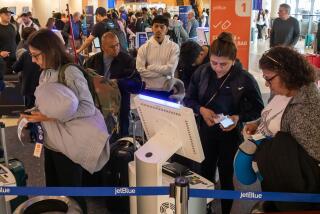No Quick Fix to Air Traffic Problems, Experts Warn
- Share via
NEW YORK — A Monday meeting of Transportation Secretary Rodney Slater, airline executives and other aviation participants has a tough agenda: fixing a rash of flight delays and cancellations and the public’s ensuing frustration.
Though the issue has been highlighted by widespread cancellations at United Airlines, which are mostly due to labor troubles, the air traffic control system itself has struggled to keep pace with growth in air travel.
“On a perfect day everything’s fine,” said John Kennedy, a spokesman for Delta Air Lines Inc. “Under ideal conditions the system operates effectively but under adverse weather it can’t adjust to the demands.”
The number of U.S. passengers more than doubled to 635 million last year compared with 278 million in 1978, the year the industry deregulated. It was expected to grow to more than 1 billion in 10 years.
But as more planes take to the skies, the system has kept to an antiquated design. Frequently described as “highways in the sky,” it has a finite number of routes and a regional system for monitoring traffic.
U.S. airport capacity has also remained limited, and the hub-and-spoke system favored by airlines has not helped--half of the traffic is carried by just 17 of the nation’s 422 commercial airports. Many airports have expansion plans but face opposition from local residents.
“The infrastructure has not been brought along at the same pace [as demand], never mind planning for the future,” said John Mazor, a spokesman for the Air Line Pilots Assn., which represents about 58,000 pilots at U.S. and Canadian airlines. The association will be represented at the meeting, along with top executives from major U.S. airlines and the National Air Traffic Controllers Assn.
The meeting is intended to last only 1 1/2 hours. “Either the results are preordained or it is likely to adjourn without identifying a specific prescription,” said George Hamlin, vice president of airline consultant Global Aviation Associates.
“There have been calls for re-regulation. That’s not going to happen at this meeting but that’s the implication--if [the airlines] can’t solve their problems, somebody, possibly the government, is going to help them,” he said.
Slater called the meeting shortly after an earlier meeting with United Airlines, which is owned by UAL Corp., and United’s pilots union.
“In a sense, the United situation is a red herring or misdirection,” said David Stempler, Air Travelers Assn. president. “We really have an infrastructure problem.”
Complicating matters, the airlines and regulators have a history of finger-pointing, with airlines blaming the air traffic system and the Department of Transportation blaming the airlines for their customer service records.
“If we can get together and decide [on a] path, in the next five years we can avoid the gridlock we’ve experienced this summer. Otherwise, it’s going to get worse,” Stempler said.
The current U.S. air traffic control system is divided into areas of regional coverage. If one manager gets bogged down with traffic or bad weather, he can close down that sector, which Stempler compared to closing down a section of highway without planning how to reroute the traffic.
This summer, the Federal Aviation Administration moved more control to its command center in Herndon, Va., but that has not alleviated all the problem stemming from a spate of summer thunderstorms.
The FAA likes to point to its recent successes in rolling out replacement computers and screens to controllers. But as helpful as the new screens are, they do not fundamentally change the way traffic is directed.
The big goal in air traffic control is “free flight,” which aims to give pilots a greater role in determining the best route.
New technologies will put better weather data and information about other aircraft in the cockpit to allow earlier and better-informed decisions. Pilots and controllers will also be able to replace many radio conversations with text messages, an improvement over voice messages that may need to be repeated and may be garbled.
More to Read
Sign up for Essential California
The most important California stories and recommendations in your inbox every morning.
You may occasionally receive promotional content from the Los Angeles Times.













